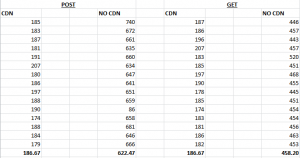The other day I did a blog post on how we are using a CDN to front our OCSP services, the CDN we are using is CloudFlare who is one of our partners.
In that blog post I mentioned that POSTs requests from an OCSP client would normally be a cache miss for a CDN and this introduces additional latency in serving these responses.
Even though the response times we were getting had this additional latency the performance was still acceptable but we wanted to do better so a few weeks ago I went to the CloudFlare office and worked with them on making their services OCSP aware.
Specifically we made it so that when they get an OCSP POST they can determine what cached response to return (for example from a prior GET) instead of going back to our responders to have our responder do that for them.
As of today this change has gone live, as you know I love numbers which is why I have been publishing these repository performance numbers. What you will see if you look at those is that our worldwide average is right around 100ms, if we take out china and Australia that figure drops to around 60ms.
The problem with these numbers is they only test the GET variant of the protocol, that is because neither Pingdom nor Monitis let me simulate binary POSTs (which is what the OCSP POST variant looks like).
With that said we can extrapolate what the numbers look like fairly easily; from my current network location (which is slow) this is what I see:
What I want you to notice here is that over 15 requests when I do a POST to the CDN instance of our responder I get the same response time average as I do when I perform the same test with the GET variant.
What this tells us is that POST is performing the exact same as a GET which from this we can safely say that in our case the performance numbers I have been publishing for GET are also accurate for POSTs.
What you will also see that our responder is slower to server via POST, this is because it is designed around nonced OCSP requests and as such isn’t optimized as much as it could be for caching them.
I should also note that our decision to put a CDN in front of our OCSP responder does not break clients that want to send nonced requests (no browsers do by default btw), these are simply treated as a cache miss.
Ryan
